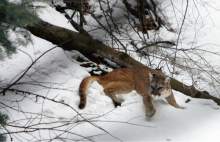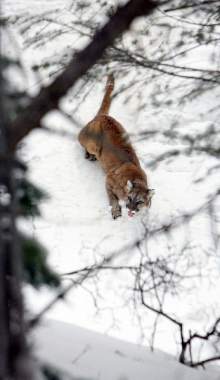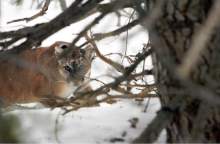This is an archived article that was published on sltrib.com in 2016, and information in the article may be outdated. It is provided only for personal research purposes and may not be reprinted.
The Utah Wildlife Board on Thursday hiked the potential cougar harvest in the face of criticism that the move could inflict irreparable harm to populations of the large feline predator and legitimize trophy hunting in the name of wildlife management.
Although the Utah Division of Wildlife Resources increased the number of permits from 495 to 532 for the 2016-17 season — which runs from Nov. 9 to May 31 — and opened a new area for unlimited hunting, the actual number of cougars killed is expected to remain far below the peak harvests in the mid-1990s, when 600 were taken in a typical year, according to Leslie McFarlane, DWR's mammals coordinator.
"All our metrics are based on data collected for cougar populations in Utah," McFarlane told the board. DWR staff recommended increased cougar takes in units where deer, elk or bighorn sheep populations struggle or where livestock depredation is a problem.
Last year's documented kill count was 394 cougars, including those targeted for being a nuisance and two roadkills. Permitted hunters bagged 371 of the 495 cougars in the quota, for a 75 percent success rate.
The proposed changes to the cougar hunt sparked a barrage of emotional emailed denunciations before Thursday's meeting, as well as petitions. Many Utahns find trophy hunting abhorrent and antithetical to wildlife conservation, yet nonhunters are not represented on the wildlife board, which is supposed to represent the interests of the entire state, said Sundays Hunt, state director of the Humane Society, and others during the public comment period.
After hearing from a parade of critics, the board unanimously approved the DWR recommendations to lower quotas in some units and raised them for 2016-2017. The board added permits for some units beyond what staff recommended, leading to a net increase of 37 permits. The quotas had been increased by 35 the year before, when the board adopted a 10-year cougar management plan.
Board Chairman John Bair assured critics that while the state has no interest in putting cougars in jeopardy, hunting them is an important Western tradition and a useful management tool.
"It might not be a part of your tradition, and that's fine," said Bair, who spoke of pleasure in watching trained dogs on a cougar chase and described the cougar mounted in his home. "It's a huge part of my family tradition. It is not fair to categorize someone who hunts cougars as unethical."
"That represents more than a hide hanging on the wall. It represents years of work and a lot of investment with friends and family, and there's a great education that goes with that," he added. "I have a lot of faith in our biologists. They don't do it for the money. They do it out of love for Utah's wildlife."
While sportsmen's groups endorsed Thursday's move, animal-welfare groups and some wildlife conservationists argued that the change is not based in sound science, but rather stems from a misguided belief that limiting cougar numbers helps big game and deters livestock depredation.
John Ziegler, a Utah physician, is an avid hiker and photographer who has spent thousands of hours on Utah trails.
"I have never seen a cougar in the wild, and I have tried," he told the board. "Cougars are indeed a scarce resource. They are so secretive that even our professionals with the best information have no real good fix on how many we have in our state."
Ziegler and others cited numerous studies that suggest cougar hunting can actually increase depredation on deer, elk and livestock. Without knowing the true strength or weakness of Utah's cougar population, critics say, DWR's proposal to increase cougar-kill quotas is not scientifically defensible.
That's not how wildlife management works, responded DWR Director Greg Sheehan. He noted that his agency oversees 1,000 species of wildlife, and that counting each of their populations is not possible. That's especially true for cougars.
"We look at indicators, we look at trends, we do modeling and come up with data sets that tell us what goes on," Sheehan said.
Cougars were not protected before 1967 and could be shot on sight. In the five decades since, these animals have been scientifically monitored and DWR requires successful hunters to bring in their dead cougars so officials can record key data. The agency estimates that the state's cougar population is between 2,500 and 4,500.
But speaker after speaker voiced skepticism that cougar populations are safe and that hunting them helps big game.
"If science doesn't support cougar hunting, then it is done for sport and trophies and to satisfy a narrow segment of society against the wishes of the majority," said Kirk Robinson, executive director of Western Wildlife Conservancy.
Brian Maffly covers public lands for The Salt Lake Tribune. Maffly can be reached at bmaffly@sltrib.com or 801-257-8713. Twitter: @brianmaffly







